2013 VOLKSWAGEN TOUAREG airbag
[x] Cancel search: airbagPage 103 of 440
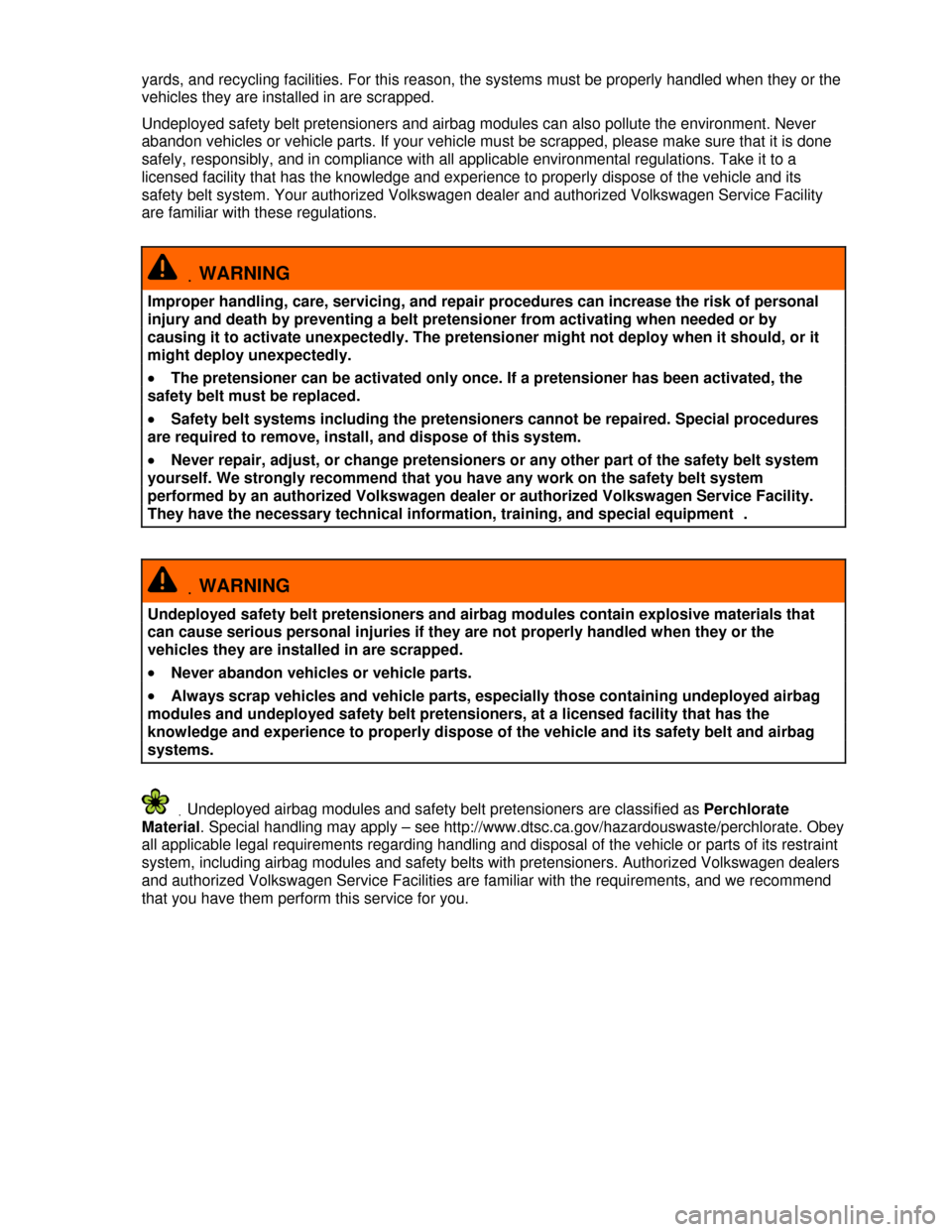
yards, and recycling facilities. For this reason, the systems must be properly handled when they or the
vehicles they are installed in are scrapped.
Undeployed safety belt pretensioners and airbag modules can also pollute the environment. Never
abandon vehicles or vehicle parts. If your vehicle must be scrapped, please make sure that it is done
safely, responsibly, and in compliance with all applicable environmental regulations. Take it to a
licensed facility that has the knowledge and experience to properly dispose of the vehicle and its
safety belt system. Your authorized Volkswagen dealer and authorized Volkswagen Service Facility
are familiar with these regulations.
.WARNING
Improper handling, care, servicing, and repair procedures can increase the risk of personal
injury and death by preventing a belt pretensioner from activating when needed or by
causing it to activate unexpectedly. The pretensioner might not deploy when it should, or it
might deploy unexpectedly.
�x The pretensioner can be activated only once. If a pretensioner has been activated, the
safety belt must be replaced.
�x Safety belt systems including the pretensioners cannot be repaired. Special procedures
are required to remove, install, and dispose of this system.
�x Never repair, adjust, or change pretensioners or any other part of the safety belt system
yourself. We strongly recommend that you have any work on the safety belt system
performed by an authorized Volkswagen dealer or authorized Volkswagen Service Facility.
They have the necessary technical information, training, and special equipment .
.WARNING
Undeployed safety belt pretensioners and airbag modules contain explosive materials that
can cause serious personal injuries if they are not properly handled when they or the
vehicles they are installed in are scrapped.
�x Never abandon vehicles or vehicle parts.
�x Always scrap vehicles and vehicle parts, especially those containing undeployed airbag
modules and undeployed safety belt pretensioners, at a licensed facility that has the
knowledge and experience to properly dispose of the vehicle and its safety belt and airbag
systems.
.Undeployed airbag modules and safety belt pretensioners are classified as Perchlorate
Material. Special handling may apply – see http://www.dtsc.ca.gov/hazardouswaste/perchlorate. Obey
all applicable legal requirements regarding handling and disposal of the vehicle or parts of its restraint
system, including airbag modules and safety belts with pretensioners. Authorized Volkswagen dealers
and authorized Volkswagen Service Facilities are familiar with the requirements, and we recommend
that you have them perform this service for you.
Page 136 of 440
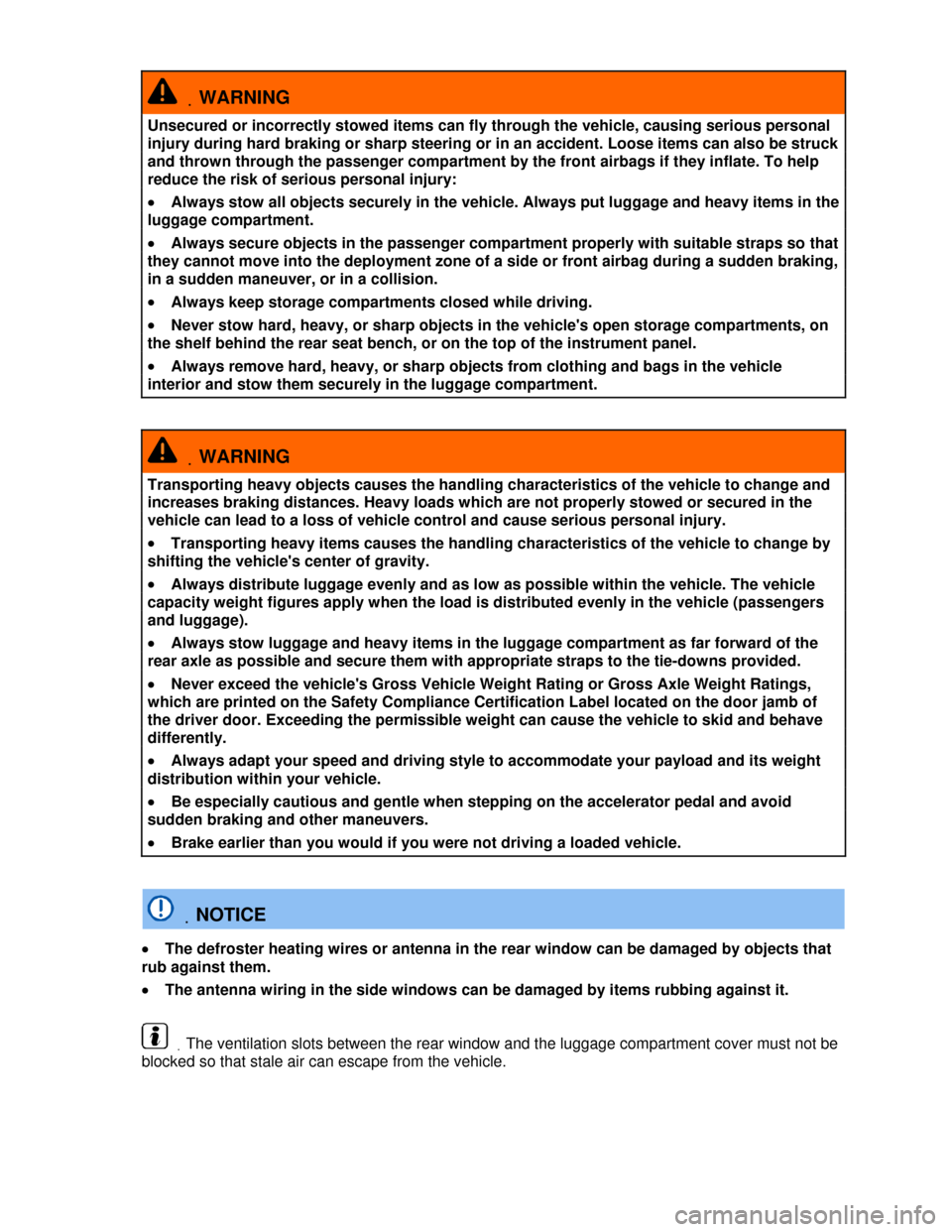
.WARNING
Unsecured or incorrectly stowed items can fly through the vehicle, causing serious personal
injury during hard braking or sharp steering or in an accident. Loose items can also be struck
and thrown through the passenger compartment by the front airbags if they inflate. To help
reduce the risk of serious personal injury:
�x Always stow all objects securely in the vehicle. Always put luggage and heavy items in the
luggage compartment.
�x Always secure objects in the passenger compartment properly with suitable straps so that
they cannot move into the deployment zone of a side or front airbag during a sudden braking,
in a sudden maneuver, or in a collision.
�x Always keep storage compartments closed while driving.
�x Never stow hard, heavy, or sharp objects in the vehicle's open storage compartments, on
the shelf behind the rear seat bench, or on the top of the instrument panel.
�x Always remove hard, heavy, or sharp objects from clothing and bags in the vehicle
interior and stow them securely in the luggage compartment.
.WARNING
Transporting heavy objects causes the handling characteristics of the vehicle to change and
increases braking distances. Heavy loads which are not properly stowed or secured in the
vehicle can lead to a loss of vehicle control and cause serious personal injury.
�x Transporting heavy items causes the handling characteristics of the vehicle to change by
shifting the vehicle's center of gravity.
�x Always distribute luggage evenly and as low as possible within the vehicle. The vehicle
capacity weight figures apply when the load is distributed evenly in the vehicle (passengers
and luggage).
�x Always stow luggage and heavy items in the luggage compartment as far forward of the
rear axle as possible and secure them with appropriate straps to the tie-downs provided.
�x Never exceed the vehicle's Gross Vehicle Weight Rating or Gross Axle Weight Ratings,
which are printed on the Safety Compliance Certification Label located on the door jamb of
the driver door. Exceeding the permissible weight can cause the vehicle to skid and behave
differently.
�x Always adapt your speed and driving style to accommodate your payload and its weight
distribution within your vehicle.
�x Be especially cautious and gentle when stepping on the accelerator pedal and avoid
sudden braking and other maneuvers.
�x Brake earlier than you would if you were not driving a loaded vehicle.
.NOTICE
�x The defroster heating wires or antenna in the rear window can be damaged by objects that
rub against them.
�x The antenna wiring in the side windows can be damaged by items rubbing against it.
.The ventilation slots between the rear window and the luggage compartment cover must not be
blocked so that stale air can escape from the vehicle.
Page 173 of 440
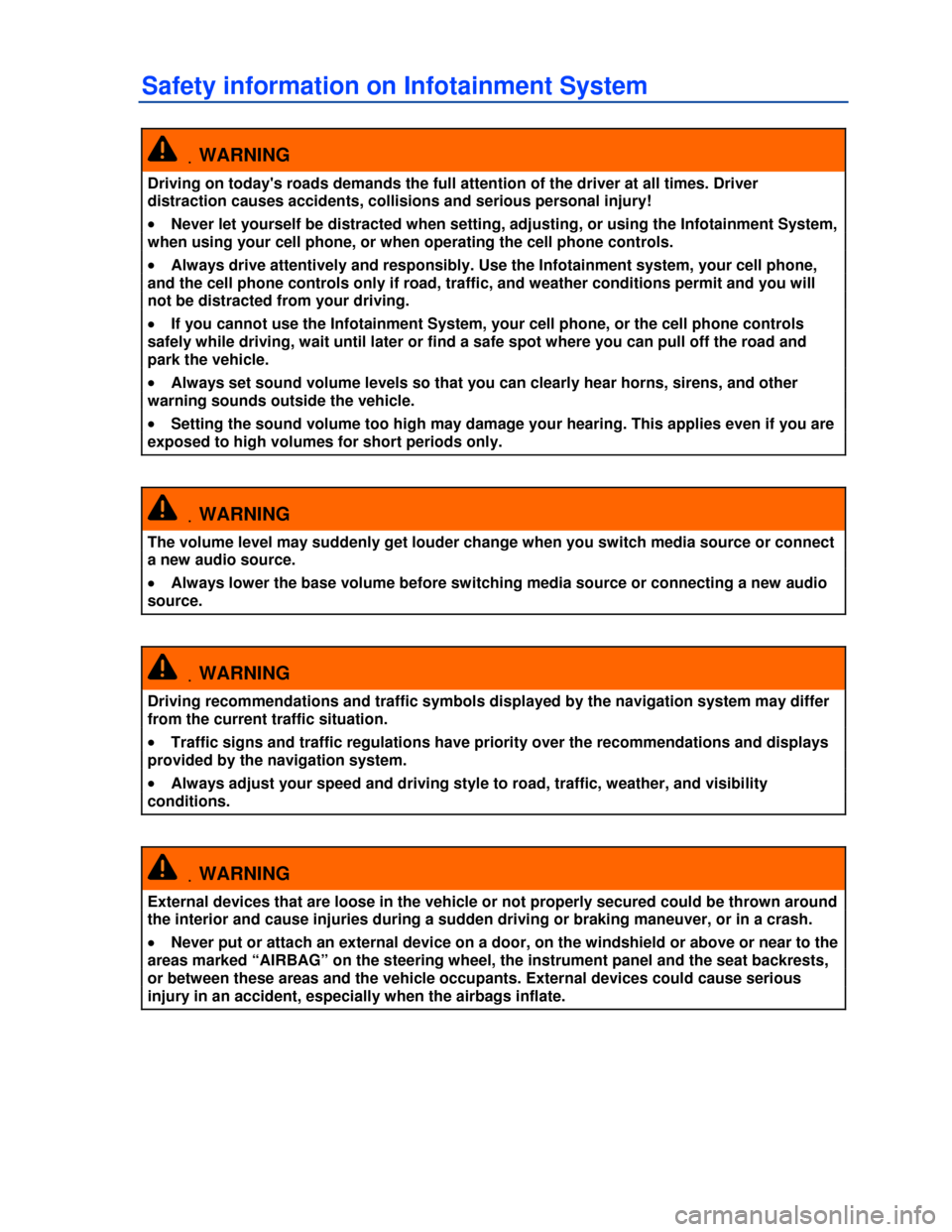
Safety information on Infotainment System
.WARNING
Driving on today's roads demands the full attention of the driver at all times. Driver
distraction causes accidents, collisions and serious personal injury!
�x Never let yourself be distracted when setting, adjusting, or using the Infotainment System,
when using your cell phone, or when operating the cell phone controls.
�x Always drive attentively and responsibly. Use the Infotainment system, your cell phone,
and the cell phone controls only if road, traffic, and weather conditions permit and you will
not be distracted from your driving.
�x If you cannot use the Infotainment System, your cell phone, or the cell phone controls
safely while driving, wait until later or find a safe spot where you can pull off the road and
park the vehicle.
�x Always set sound volume levels so that you can clearly hear horns, sirens, and other
warning sounds outside the vehicle.
�x Setting the sound volume too high may damage your hearing. This applies even if you are
exposed to high volumes for short periods only.
.WARNING
The volume level may suddenly get louder change when you switch media source or connect
a new audio source.
�x Always lower the base volume before switching media source or connecting a new audio
source.
.WARNING
Driving recommendations and traffic symbols displayed by the navigation system may differ
from the current traffic situation.
�x Traffic signs and traffic regulations have priority over the recommendations and displays
provided by the navigation system.
�x Always adjust your speed and driving style to road, traffic, weather, and visibility
conditions.
.WARNING
External devices that are loose in the vehicle or not properly secured could be thrown around
the interior and cause injuries during a sudden driving or braking maneuver, or in a crash.
�x Never put or attach an external device on a door, on the windshield or above or near to the
areas marked “AIRBAG” on the steering wheel, the instrument panel and the seat backrests,
or between these areas and the vehicle occupants. External devices could cause serious
injury in an accident, especially when the airbags inflate.
Page 293 of 440
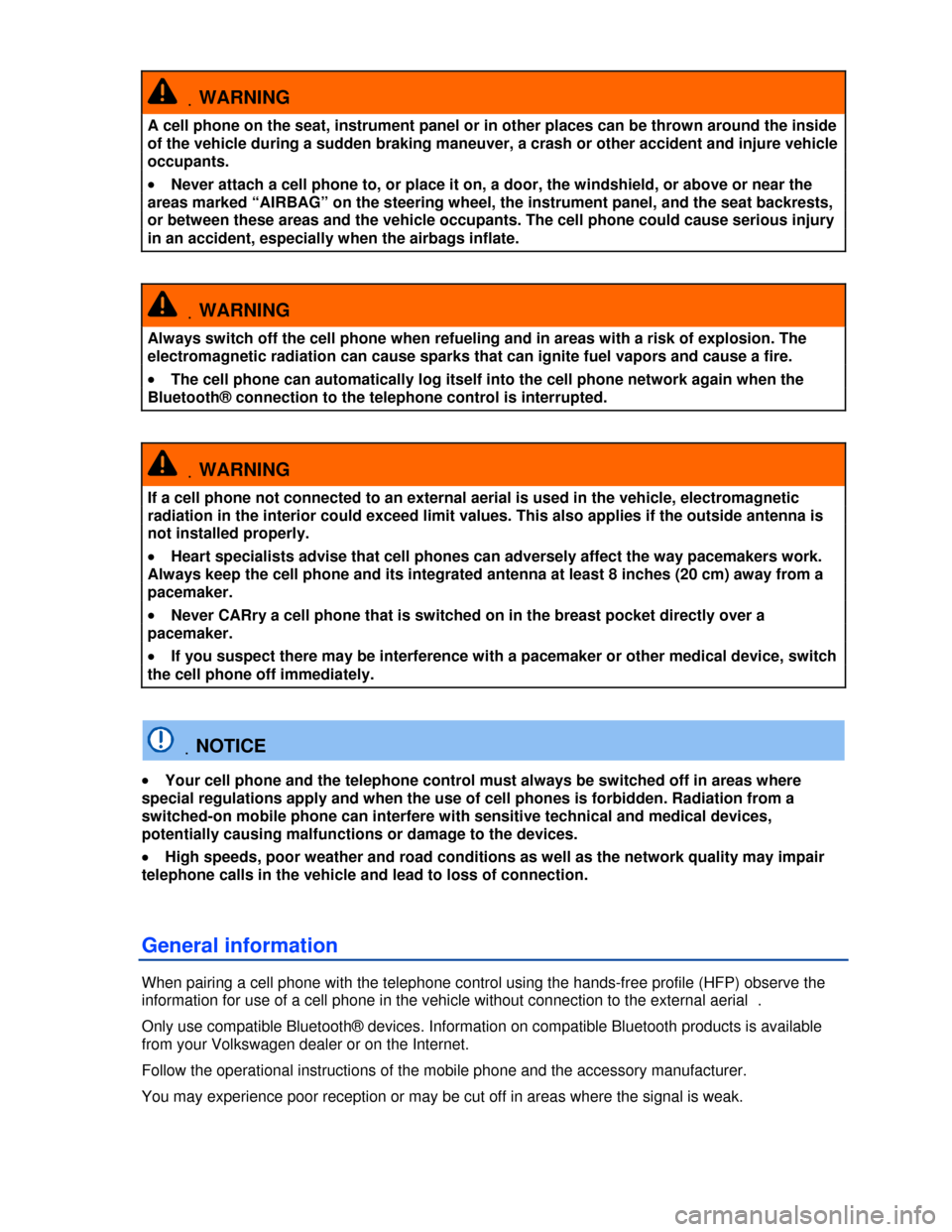
.WARNING
A cell phone on the seat, instrument panel or in other places can be thrown around the inside
of the vehicle during a sudden braking maneuver, a crash or other accident and injure vehicle
occupants.
�x Never attach a cell phone to, or place it on, a door, the windshield, or above or near the
areas marked “AIRBAG” on the steering wheel, the instrument panel, and the seat backrests,
or between these areas and the vehicle occupants. The cell phone could cause serious injury
in an accident, especially when the airbags inflate.
.WARNING
Always switch off the cell phone when refueling and in areas with a risk of explosion. The
electromagnetic radiation can cause sparks that can ignite fuel vapors and cause a fire.
�x The cell phone can automatically log itself into the cell phone network again when the
Bluetooth® connection to the telephone control is interrupted.
.WARNING
If a cell phone not connected to an external aerial is used in the vehicle, electromagnetic
radiation in the interior could exceed limit values. This also applies if the outside antenna is
not installed properly.
�x Heart specialists advise that cell phones can adversely affect the way pacemakers work.
Always keep the cell phone and its integrated antenna at least 8 inches (20 cm) away from a
pacemaker.
�x Never CARry a cell phone that is switched on in the breast pocket directly over a
pacemaker.
�x If you suspect there may be interference with a pacemaker or other medical device, switch
the cell phone off immediately.
.NOTICE
�x Your cell phone and the telephone control must always be switched off in areas where
special regulations apply and when the use of cell phones is forbidden. Radiation from a
switched-on mobile phone can interfere with sensitive technical and medical devices,
potentially causing malfunctions or damage to the devices.
�x High speeds, poor weather and road conditions as well as the network quality may impair
telephone calls in the vehicle and lead to loss of connection.
General information
When pairing a cell phone with the telephone control using the hands-free profile (HFP) observe the
information for use of a cell phone in the vehicle without connection to the external aerial .
Only use compatible Bluetooth® devices. Information on compatible Bluetooth products is available
from your Volkswagen dealer or on the Internet.
Follow the operational instructions of the mobile phone and the accessory manufacturer.
You may experience poor reception or may be cut off in areas where the signal is weak.
Page 330 of 440
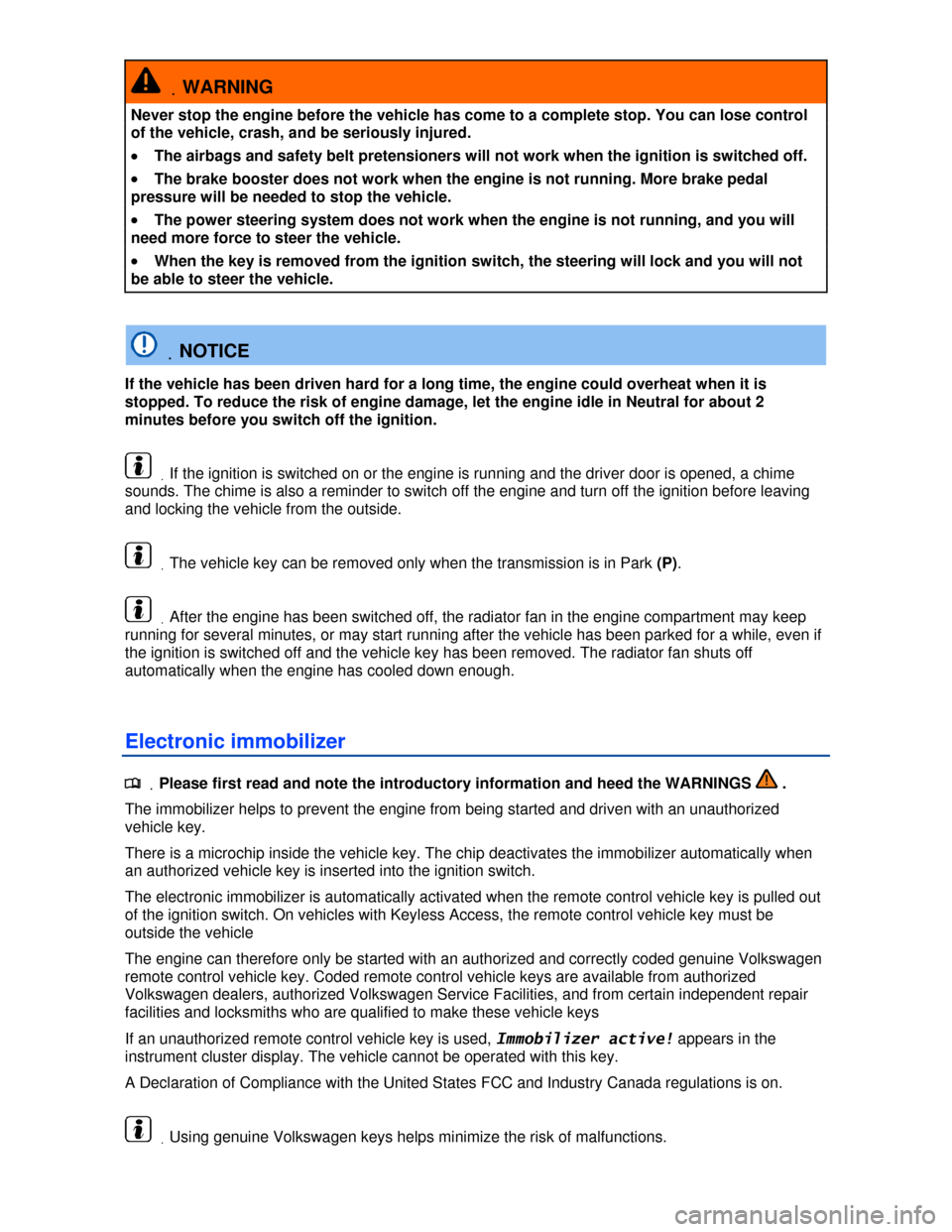
.WARNING
Never stop the engine before the vehicle has come to a complete stop. You can lose control
of the vehicle, crash, and be seriously injured.
�x The airbags and safety belt pretensioners will not work when the ignition is switched off.
�x The brake booster does not work when the engine is not running. More brake pedal
pressure will be needed to stop the vehicle.
�x The power steering system does not work when the engine is not running, and you will
need more force to steer the vehicle.
�x When the key is removed from the ignition switch, the steering will lock and you will not
be able to steer the vehicle.
.NOTICE
If the vehicle has been driven hard for a long time, the engine could overheat when it is
stopped. To reduce the risk of engine damage, let the engine idle in Neutral for about 2
minutes before you switch off the ignition.
.If the ignition is switched on or the engine is running and the driver door is opened, a chime
sounds. The chime is also a reminder to switch off the engine and turn off the ignition before leaving
and locking the vehicle from the outside.
.The vehicle key can be removed only when the transmission is in Park (P).
.After the engine has been switched off, the radiator fan in the engine compartment may keep
running for several minutes, or may start running after the vehicle has been parked for a while, even if
the ignition is switched off and the vehicle key has been removed. The radiator fan shuts off
automatically when the engine has cooled down enough.
Electronic immobilizer
.�
Page 392 of 440

In order to: You must ⇒fig.134Result:
Reduce set speed (while
cruise control is actively
controlling vehicle
speed).
Push the lever briefly to the
�3�0�%�%�$ – position (–) to reduce
speed in increments of 5 mph
(10 km/h) and store.
Cruise control will slow the vehicle
down without braking by reducing the
flow of fuel to the engine until the new
lower speed is reached and saves the
new lower speed in the memory. Push and hold the lever in the
�3�0�%�%�$ – position (–) to reduce the
set speed until the lower desired
speed is reached and the button
is released.
Switch off cruise control. Move the lever to the �/�&�&position
(B).
System is switched off. The set speed
is deleted.
Driving downhill with cruise control
If cruise control cannot maintain constant speed while driving downhill, slow the vehicle with the foot
brake and downshift if necessary.
Automatic deactivation
Cruise control speed regulation is automatically deactivated or temporarily interrupted:
�x If the system detects an error that could affect the function of the cruise control.
�x If the vehicle has accelerated and goes faster than the stored speed for a longer time.
�x If the brake or clutch pedal is depressed.
�x If the vehicle shifts gear (manual transmission).
�x If an airbag deploys.